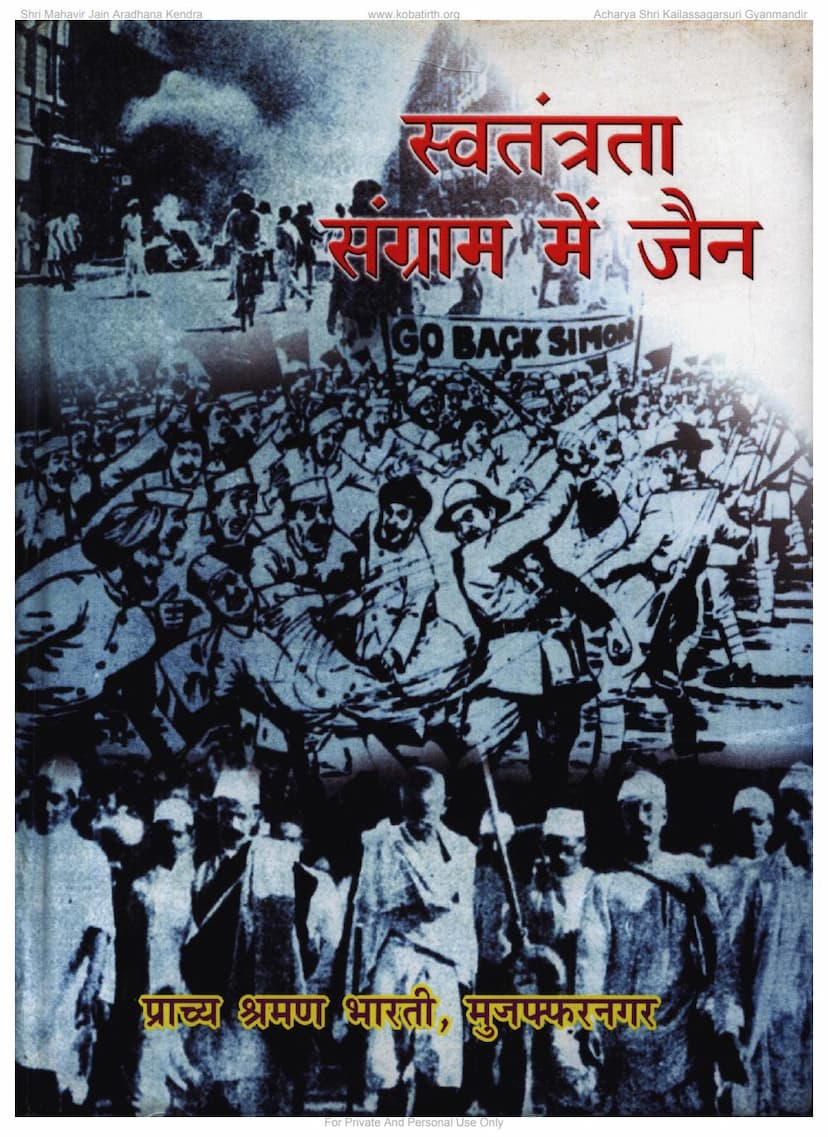Swatantrata Sangram Me Jain
Added to library: September 2, 2025

Summary
This Jain text, titled "Swatantrata Sangram Mein Jain" (Jains in the Freedom Struggle), authored by Kapurchand Jain and Jyoti Jain and published by Prachya Shraman Bharati, is a monumental work dedicated to documenting the contributions of Jains to India's independence movement. The provided text covers the initial sections of the first volume, focusing on the historical context and introducing key figures and philosophical underpinnings.
Here's a comprehensive summary of the provided text:
Core Theme: The book aims to highlight the often-overlooked but significant role of Jains in India's freedom struggle, from ancient times to the modern independence movement. It emphasizes that while Jainism is primarily known for its principles of non-violence (Ahimsa), its followers have actively participated in defending the nation and fighting for its liberation when the nation's honor was threatened.
Historical Context and Jain Philosophy:
- Ancient Roots: The text traces the deep historical roots of Jainism in India, mentioning the teachings of Lord Rishabhdev (the first Tirthankar) in areas like governance, social order, and economics. It highlights the concept of "Anekantvad" (non-absolutism) as the basis for "Ahisnak Yuddh" (non-violent warfare), citing the legendary, non-violent conflict between Bharat and Bahubali as an example.
- Jain Rulers and Contributions: The book details the patronage and influence of Jainism across various Indian dynasties, including the Mauryas (mentioning Chandragupta Maurya's connection), Kharavela of Kalinga, the Gangas, Chalukyas, Rashtrakutas, Cholas, Hoysalas, Tomaras, Paramaras, Chauhans, Tomaras, and Rajput rulers of Mewar, Marwar, and Jaipur. It highlights how Jain kings, ministers, generals, and treasurers significantly contributed to the political, cultural, and economic development of India.
- Jain Principles in Action: The text underscores how Jain principles, particularly non-violence and truth, have influenced historical figures, including Mahatma Gandhi, who drew inspiration from Jain monks and personalities like Shrimad Rajchandra.
- The Significance of Ahimsa: While Jainism is fundamentally based on Ahimsa, the book makes it clear that this did not prevent Jains from participating in national defense. The emphasis is on defending the nation and upholding its honor, even if it involved actions that might appear contrary to strict non-violence in extreme circumstances.
Key Figures and Movements:
- Jain Martyrs: The book emphasizes the sacrifices of Jain martyrs who laid down their lives for India's freedom. It specifically mentions Lala Hukumchand Jain, Amar Chand Bathia, Motichand Shah, Singhi Premchand Jain, Veer Satappa Topannavar, Veer Udhavchand Jain, Sabulal Jain Baisakhiya, Kumari Jayavati Sanghvi, Nathalal Shah, Anna Patavale, Maganlal Oswal, Bhupal Anaskure, Kambhilaal Jain, Mulayamchand Jain, Chaudhari Bhayyalal, Chauthmal Bhandari, Bhupal Pandit, Bharmal, and Harishchand Dagadoba Jain as early contributors, particularly from the 1857 Sepoy Mutiny.
- Freedom Fighters: The text dedicates extensive sections to introducing numerous Jain freedom fighters from various regions, especially Madhya Pradesh, Uttar Pradesh, and Rajasthan. It details their struggles, arrests, jail terms, and sacrifices.
- Jain Contributions to Institutions: The book highlights the involvement of Jains in the Indian National Congress, the Constituent Assembly (mentioning members like Ratanlal Malviya, Ajit Prasad Jain, Bhawani Arjun Khimji, Balwant Singh Mehta, and Kusumkant Jain), and the Azad Hind Fauj.
- Jain Journalism: The role of Jain newspapers and journalists in propagating nationalist ideas and facing suppression from the British government is also noted, citing examples like Babu Jyoti Prasad Jain's 'Jain Pradeep'.
- Jain Women in the Freedom Struggle: The text acknowledges the crucial role of Jain women in the independence movement, referencing the publication of a book on this topic by Dr. Jyoti Jain.
- Spiritual Inspiration: The book acknowledges the spiritual guidance and blessings of prominent Jain Acharyas, including Acharya Shanti Sagar Ji (Chhani), Acharya Suryasagar Ji, Acharya Vijaysagar Ji, Acharya Vimalsagar Ji, Acharya Sumatisagar Ji, and Upadhyay 108 Gyan Sagar Ji Maharaj, who inspired this work.
Scope and Structure (as indicated by the text): The book is planned in three volumes:
- Volume 1 (the current section): Introduces Amar Jain Martyrs and primarily focuses on Jain freedom fighters from Uttar Pradesh, Madhya Pradesh, and Rajasthan.
- Volume 2: Will cover freedom fighters from other states and remaining figures from Uttar Pradesh, Madhya Pradesh, and Rajasthan.
- Volume 1 (continued): It includes detailed sections like "Bolte Shabd Chit" (Speaking Word Pictures) covering historical Jain figures from Lord Rishabhdev to the 1857 revolt, "Swatantrata Andolan: Ek Sinhavalokan" (Freedom Movement: An Overview) summarizing key events from 1857 to 1947, and "Amar Jain Shaheed" (Immortal Jain Martyrs). It also includes appendices on Jain involvement in the Constituent Assembly, Azad Hind Fauj, and Jain journalism.
Methodology and Acknowledgment: The authors emphasize their decade-long effort in researching and compiling this extensive material, drawing from historical Jain texts, government lists, books, magazines, and personal accounts. They acknowledge the challenges in verifying information due to the voluntary nature of Jain participation and the lack of formal claims for benefits, which sometimes led to names not appearing in official records.
Overall Tone: The book is presented with reverence for the Jain spiritual tradition and a deep sense of pride in the community's contribution to India's national awakening and freedom struggle. It aims to bring these contributions to light for wider recognition and historical accuracy.